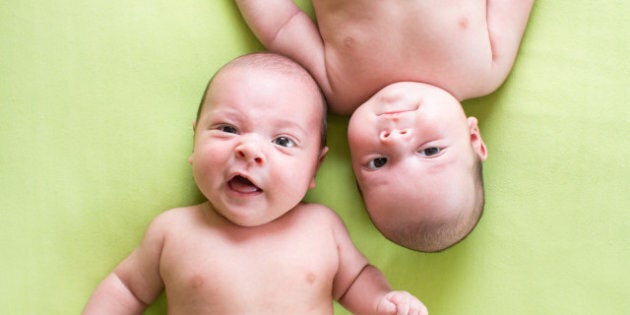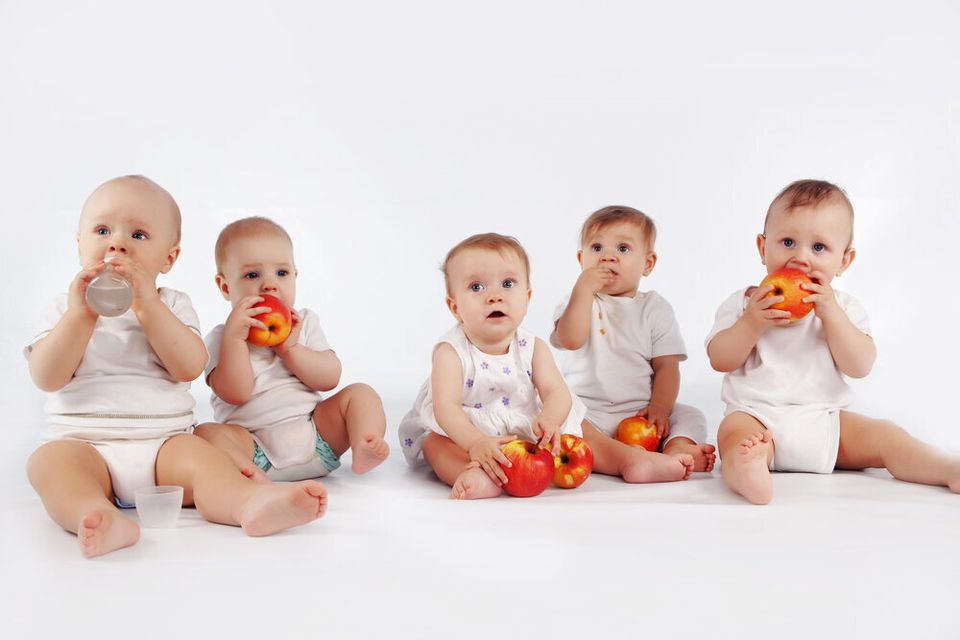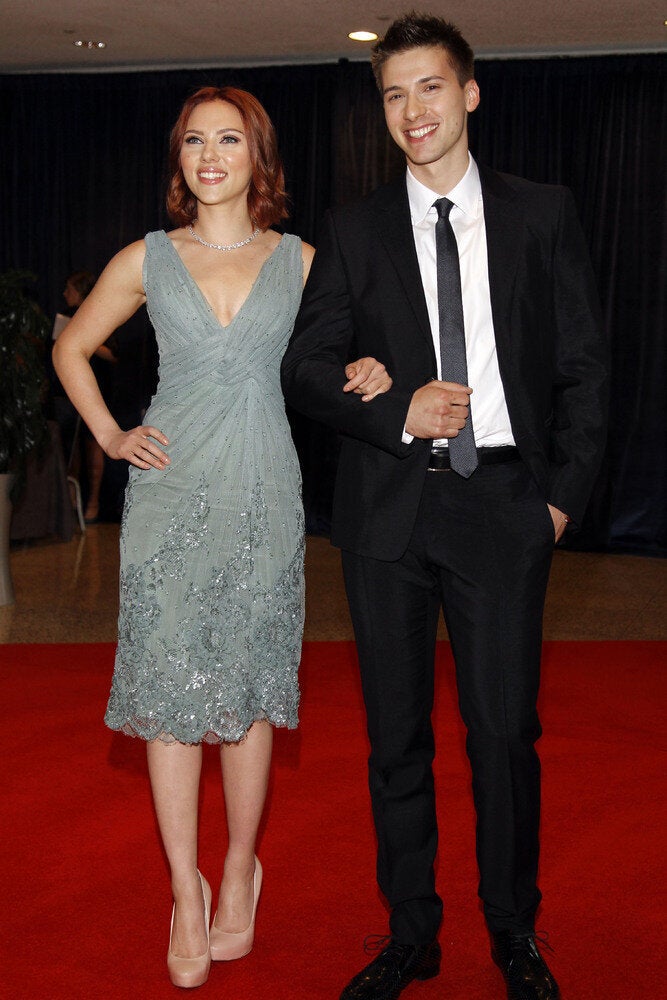

What is it about twins that’s so darn fascinating? We idolize them when they’re famous (ahem, Mary Kate and Ashley), we envy them when we’re young (I know I’m not the only one who dreamed of having an identical partner-in-crime as a kid!) — some women even stick to conception-friendly diets said to increase their chances of having adorable little duos.
But no matter why we love ’em, there’s one thing for sure: With a recent report from the U.S Centres for Disease Control and Prevention (CDC) disclosing that more twins are being born in the United States now than ever before (birth rates have soared more than 70 per cent in the past 30 years), there’s going to be a lot more pairs to go around!
And with such a surge, there’s no better time to learn more about them. For example, did you know that there’s a “twins gene” — or that two twins can have totally different dads? Brush up on your twosome health trivia here.
Twins Are Multiplying
Nope, you don’t need an eye exam — you really are seeing double. According to a recent CDC report, the birth rate for twins has increased a whopping 76 per cent since 1980.
In fact, one in every 30 babies born in 2009 was a twin (compared to 1980, when the rate was one baby in every 53). What’s with the binary-baby boom? One factor contributing to the upsurge: The age of mothers has trended up over the years, and a woman in her thirties is more likely to have twins than someone in her twenties, according to the study’s lead author, epidemiologist Joyce Martin, MPH. However, while age is an independent risk factor for twins, it also tends to correlate with increased use of fertility treatments, which was likely the biggest contributor to the spike in twin births.
Unfortunately, there are risks involved in multiple births — more than half of twins are born at a low birth weight, which can increase the risk of long-term health problems, such as asthma. And mom’s also at risk: Having twins ups her odds for gestational hypertension and diabetes, as well as for having a C-section.
Yep, There's a ‘Twin Gene’
Know any families with multiple sets of multiples? There may be a scientific explanation behind all that multiplying — hyper-ovulation.
If a woman inherits a certain gene that causes her to hyper-ovulate (meaning she’s more likely to release multiple eggs during ovulation), her chance of having fraternal twins — which are produced from two separate eggs — increases. And since that gene is, well, genetic, parents may also pass it on to their kids, making it possible for twins to run in the family (and perhaps even for twins to have their own little sets of twins). However, there’s no known gene linked to identical twins — which results when one egg splits in half — so this twin type isn’t hereditary.
And what about that long-held idea that twins tend to skip a generation? According to an explanation in The New York Times, the theory may have gotten its roots since only women are affected by the hyper-ovulation gene (since men don’t ovulate) — but men can in fact pass it on to their daughters (hence, seemingly “skipping” a generation).
Twins Can Be Born Years Apart
Reuben Blake (pictured left) is 5 years old. His twin sister Floren? She’s about 2 months old. Huh?
Reuben and Floren’s parents Simon and Jody Blake were having trouble getting pregnant, so they tried in vitro fertilization (a process in which a woman’s eggs are fertilized outside of her body and then implanted in her uterus). Two embryos were implanted in Mrs. Blake (only one of which was successful — Reuben!), and the couple decided to have the other three embryos frozen.
A few years later, they implanted another embryo and nine months later, Reuben’s twin sister was born. "It does depend how you interpret the term 'twins' — twins generally means that they are born at the same time,” Valentine Akande, MD, lead clinician and director of fertility services at the Bristol Centre for Reproductive Medicine, told The Telegraph. "But, yes, twins in that they have come from the same batch of embryos, collected from the same treatment cycle — so twins born at a different time."
In addition, it’s not uncommon for twins to enter the world during different years. Take, for example, Buffalo, N.Y.’s Ronan Rosputni (who was born at 11:37 p.m .on Dec. 31, 2011) and his brother Rory (who was born at 12:10 a.m. on Jan. 1), according to Huffington Post.
Twins Can Have Different Dads — and Be Different Races
Okay… twins can be of different ages — but they’ve got to have the same set of parents, right?
It’s rare, but it is possible for a woman to release two eggs during ovulation and then get impregnated by two different men at the same time — also known as heteropaternal superfecundation. In fact, about 1 to 2 per cent of all fraternal twins have different dads, Hilda Hutcherson, MD, clinical professor of obstetrics and gynecology at Columbia University, recently told Today.
Heteropaternal superfecundation can also be the result of a botched fertilization procedure. In one particularly shocking case, Dutch couple Wilma and Willem Stuart were surprised when they welcomed twin baby boys to the world — one was white and one was black. A year and a half later, the couple discovered that another man’s sperm had accidently been mixed with Mr. Stuart’s during the in vitro process.
Some Twosomes Speak ‘Twin Talk’
If you’ve ever seen two young siblings readily conversing in complete gibberish, you likely witnessed idioglossia — an autonomous language often created and shared between twins (remember that YouTube video of two chatty, 18-month old twins that went viral in 2011?).
According to research published in the journal Institute of General Linguistics, about 40 per cent of twins invent their own languages. The researchers believe that super-close siblings (they don’t actually have to be twins, but usually are) sometimes use each other as models for learning vocabulary, applying meaning to sounds — even if those sounds are complete nonsense. Usually their special lingo disappears as their vocabulary expands and by the time they start school, but not always.
In the book Twin Connections: Stories That Celebrate the Mysterious Bond Behind Twins, authors Denise and Heather Allan (who are identical twins!) write: "We speak to each other in a language no one else can understand, nor can we enlighten them. We didn't realize this until we were 6 or 7 years old when someone pointed it out.”
Twins Start Bonding in Mom's Belly
No wonder twins share such an unbreakable bond — they get a head start on the rest of us.
Researchers from University of Padova in Italy recently studied 3D ultrasound videos of five sets of twins in the womb. When the fetuses were just 14 weeks old, the researchers noticed that the pairs seemed to be reaching out for each other, touching head to head and arm to head. At 18 weeks, they were stroking each other more often and were in physical contact about 30 per cent of the time. Even more phenomenal, the fetuses seemed to be extra gentle when touching around their siblings’ eyes (likely because this area is so delicate, the researchers posit).
Previous research has noted that twins appear to interact socially with each other just hours after birth — and the University of Padova researchers believe they may just be wired to do so.
There's a Twin-Inducing Diet
Want to have twins? Stock up on cheese and start chugging milk.
According to a study published in the Journal of Reproductive Medicine by Gary Steinman, MD, PhD, an ob-gyn at Long Island Jewish (LIJ) Medical Center in New Hyde Park, N.Y., women who consume dairy products may increase their chances of conceiving twins. When Dr. Steinman looked at the twin birth rates of vegans (who don’t eat any animal products, including dairy) compared to non-vegans, he discovered that the latter group was five times more likely to have two little bundles of joy.
In the British journal The Lancet, Steinman explains that the level of a certain protein (IGF, or insulin-like growth factor) is 13 times higher in women who consume dairy than in vegans. This protein increases the ovaries’ sensitivity to follicle stimulating hormone, which triggers ovulation .
Research shows that conceiving twins is also more common among older women, women who are obese, and women who are breastfeeding (in fact, a study shows that moms who are breastfeeding when they get pregnant are a whopping nine times more likely to have twins than those who aren't).
One Brazilian Town Is Booming With Multiples
The small South American town of Cândido Godói may just be the twin capital of the world. From 1959 to 2008, a whopping 8 per cent of births in São Pedro (one of the town’s villages), resulted in twins — compared to less than 1 per cent throughout the rest of the country.
What’s the reason behind so many doubles? For years, citizens believed there must have been something in the water, according to an article in The New York Times. But recent research by a team of Brazilian geneticists put that rumor to rest. After conducting a series of DNA tests, the researchers found that a hyper-ovulation gene that makes women more susceptible to conceiving twins runs rampant in the town, likely due to high levels of inbreeding.
But Cândido Godói isn’t the only place to get noticed for its high twin population: In 2010, Baker High School in Baldwinsville, N.Y., made headlines when 12 sets of twins graduated at the same time, breaking a Guinness World Record.
When Twins Are Separated at Birth, Scientists Pay Attention
Thanks to the whole “nature vs. nurture” debate, twins who get separated at birth receive a whole lot of attention from researchers (would they have the same values? Health habits? Psychological patterns?). But because you can’t just split up twins in the name of science, very few studies have been able to track twins who live completely separate lives.
However, there is the case of Meredith Grace Rittenhouse and Meredith Ellen Harrington — fraternal twin sisters born in China but adopted by two different American families. When the girls were adopted in 2003, neither of their families knew their daughter had a twin, according to an article by Newsweek. When Meredith Ellen was 2 she told her parents, "I'm so lonely. I wish I had a sister." At 3 years old, Meredith Grace was asked to complete the sentence "When I grow up I want to be a …” Her response? “Sister.” A few years later, Meredith Grace’s father was online, looking at other parents who had adopted from the same agency. There he saw a picture of a young girl who uncannily looked like his daughter. The first time they met, Meredith Ellen told Meredith Grace, "I think we were born together."
Now the two Merediths have given researchers a chance to study what they so often can’t. Nancy Segal, PhD, director of the Cal State Fullerton Twin Studies Center, has started tracking the intellectual development and personalities of the girls — as well as nine other sets of Chinese twins separated at birth and 30 pairs who were raised together.
Identical Twins Aren't Exactly Identical
They come from the same egg and look so similar it can be impossible to tell them apart — but anyone who knows a set of identical twins knows that not they’re actually carbon copies of each other. And researchers are continuing to discover why identical twins aren’t quite as indistinguishable as once thought.
A recent study published in the Proceedings of the National Academy of Sciences reported that environmental factors such as dietary habits and chemical exposures — also known as epigenetic effects — cause identical twins to grow dissimilar over time, according to a Live Science article. For example, identical duos may start to look less alike over the years, they can have totally different personalities, and one may wind up with a disease like cancer while the other doesn’t (another study from Duke University found that when one identical twin in his late seventies has Alzheimer’s, the other only has it about 40 per cent of the time).
For the study, the researchers looked at 40 identical duos in Spain ranging in age from 3 to 74, surveying them on a number of different lifestyle factors, such as exercise and eating habits. Out of the participants, the older sets of twins were the least alike.
Happy Birthday to the World's Oldest Twins!
204 — that’s the combined age of Ena Pugh and Lily Millward, a pair of British twins who both celebrated their 102nd birthdays on Jan. 4. And the duo had a whole lot to rejoice: The milestone landed them in the Guinness Book of World Records for being the oldest twins on the planet.
"They took great delight at seeing their picture in the Guinness Book of Records — they are both very proud of their title," Lily’s daughter Dianne Powell told the UK’s Sun. The pair spent the day together as they do almost every year, even though Lily was in the hospital with a broken hip.
Broken hip or not, the two say they have lived healthy, happy lives (they still live in their own houses near Brecon, England). “We’ve been very lucky and we have always had good health,” Lily told the Wales News Service. But what’s their secret to a long, centenarian life? “Laughter and a good joke,” she said.
These Celebs Have Less-Famous Twins
Hunter Johansson (left). Michael Kutcher. Patricia Bundchen.
Ever heard of them? Probably not — but we’re willing to bet you’re familiar with their fraternal twin siblings, Scarlett, Ashton, and Gisele.
And these celebrities aren’t the only ones with other halves: 24’s Keifer Sutherland has a twin sister named Rachel; Jon Heder of Napoleon Dynamite has an identical double, Daniel; and Alanis Morissette shares a birthday with her brother Wade.
Moms Living Longer?
After digging up the birth records of more than 59,000 women between 1800 and 1970, University of Utah researchers found that moms of twins tend to live longer than moms without twins.
More Than Just 2 Types
There are more than just fraternal and identical twosomes; other rare twin types include “half identical twins” (when the egg splits and then each half is fertilized) and mirror image twins (identical twins who develop asymmetrically).
Unique DNA
Identical twins don’t have identical fingerprints.
Morning Sickness
Moms who are expecting two tend to have higher levels of morning sickness, likely because of increased levels of the hormone human chorionic gonadotropin (HCG).
A 6th Sense?
One pair of conjoined twins share a “neural bridge” — and they can literally read each others’ minds, according to an article by The New York Times.
Solving The Mystery
Using an ultrasound isn’t the only way doctors can detect a twin pregnancy — some figure it out when they hear two tiny heartbeats through their stethoscope.
Double And Trouble?
A study recently published in the journal Obstetrics & Gynecology reported that parents of twins are slightly more likely to get divorced than parents without twins.
Gaining The Pounds
Moms-to-be expecting one child tend to gain 25 to 35 pounds during pregnancy. But if you’re pregnant with twins? You can expect to gain a whopping 35 to 45 pounds.
Also on HuffPost

